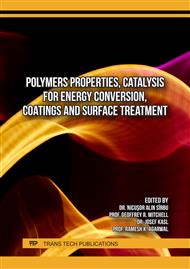[1]
Umer, M. H., Rehman, M. A. U., Ali, S., Raza, A., Muzammil, L., Ijaz, M., Khan, M. B., & Zafar, M. Q. (2024). Significance of Infill Density on Mechanical Performance in Fused Deposition Modeling. MATEC Web of Conferences.
DOI: 10.1051/matecconf/202439801030
Google Scholar
[2]
Abdulridha, H., & Abbas, T. (2023). Analyzing the Impact of FDM Parameters on Compression Strength and Dimensional Accuracy in 3D printed PLA Parts. Maǧallaẗ Al-Handasaẗ Wa-al-Tiknūlūǧiyā.
DOI: 10.30684/etj.2023.143615.1599
Google Scholar
[3]
Dev, S., & Srivastava, R. (2021). Effect of infill parameters on material sustainability and mechanical properties in fused deposition modelling process: a case study.
DOI: 10.1007/S40964-021-00184-4
Google Scholar
[4]
Suteja, T. J. (2024). Experimental Investigation of Infill Parameters Influence on Compressive Strength-to-Mass Ratio of PLA 3D Printed Part.Journal of Mechanical Engineering.
DOI: 10.24191/jmeche.v21i1.25358
Google Scholar
[5]
Chihi, M., Tarfaoui, M., Qureshi, Y., Daly, M., & Bouraoui, C. (2023). Experimental investigation of the effect of infill parameters on dynamic compressive performance of 3D-Printed carbon fiber reinforced polyethylene terephthalate glycol composites. Journal of Thermoplastic Composite Materials.
DOI: 10.1177/08927057231222805
Google Scholar
[6]
Daly, M., Tarfaoui, M., Bouali, M., & Bendarma, A. (2024). Effects of Infill Density and Pattern on the Tensile Mechanical Behavior of 3D-Printed Glycolyzed Polyethylene Terephthalate Reinforced with Carbon-Fiber Composites by the FDM Process. Journal of Composites Science.
DOI: 10.3390/jcs8040115
Google Scholar
[7]
Dakhil, G., Salih, R. M., & Hameed, A. M. (2023). Influence of Infill Pattern, Infill Ratio on Compressive Strength and Hardness of 3D Printed Polylactic Acid (PLA) Based Polymer. Journal of Applied Sciences and Nanotechnology.
DOI: 10.53293/jasn.2022.4745.1141
Google Scholar
[8]
Hamed, M. A., & Abbas, T. F. (2023). The Impact of FDM Process Parameters on the Compression Strength of 3D Printed PLA Filaments for Dental Applications. Advances in Science and Technology Research Journal.
DOI: 10.12913/22998624/169468
Google Scholar
[9]
Yadav, P., Sahai, A., & Sharma, R. S. (2021). Strength and Surface Characteristics of FDM-Based 3D Printed PLA Parts for Multiple Infill Design Patterns.Journal of The Institution of Engineers : Series C.
DOI: 10.1007/S40032-020-00625-Z
Google Scholar
[10]
Wijayanto, S. E. Y., Handoko, R., Noel, J. C., Anggawirawan, T. W., & Suteja, T. J. (2022). Identifikasi jenis infill pattern pada proses 3d printing yang menghasilkan hasil cetak dengan kekuatan tekan dan panjang filamen yang optimal.Jurnal Rekayasa Mesin.
DOI: 10.21776/jrm.v13i2.1097
Google Scholar
[11]
Christakopoulos, F., van Heugten, P. M. H., & Tervoort, T. A. (2022). Additive Manufacturing of Polyolefins. Polymers, 14(23), 5147.
DOI: 10.3390/polym14235147
Google Scholar
[12]
Schirmeister, C. G., Hees, T., Licht, E. H., & Mülhaupt, R. (2019). 3D printing of high density polyethylene by fused filament fabrication. Additive Manufacturing, 28, 152–159.
DOI: 10.1016/J.ADDMA.2019.05.003
Google Scholar
[13]
Montoya-Ospina, M. C., Zeng, J., Tan, X., & Osswald, T. A. (2023). Material Extrusion Additive Manufacturing with Polyethylene Vitrimers. Polymers, 15(6), 1332.
DOI: 10.3390/polym15061332
Google Scholar
[14]
Vidakis, N., Petousis, M., Maniadi, A., Papadakis, V. M., & Manousaki, A. (2022). MEX 3D Printed HDPE/TiO2 Nanocomposites Physical and Mechanical Properties Investigation. Journal of Composites Science, 6(7), 209.
DOI: 10.3390/jcs6070209
Google Scholar


